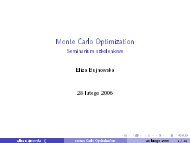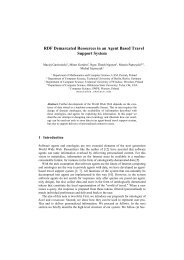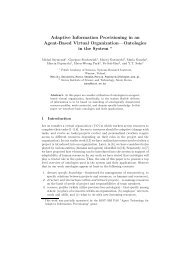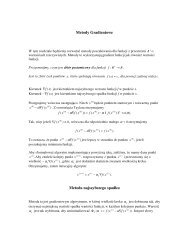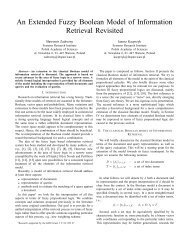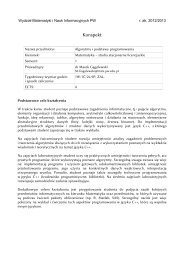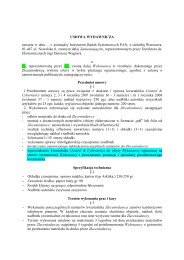Knowledge Management in an E-commerce System
Knowledge Management in an E-commerce System
Knowledge Management in an E-commerce System
Create successful ePaper yourself
Turn your PDF publications into a flip-book with our unique Google optimized e-Paper software.
<strong>Knowledge</strong> <strong>M<strong>an</strong>agement</strong> <strong>in</strong> <strong>an</strong> E-<strong>commerce</strong> <strong>System</strong> 12“<strong>Knowledge</strong> tr<strong>an</strong>sfer” is a view upon a view, <strong>an</strong> ontology of ontologies, which not only describes the existence of specificknowledge but also the knowledge that governs the <strong>in</strong>teraction between users of that knowledge. In this way knowledgetr<strong>an</strong>sfer overlooks the customer-supply ontology, the org<strong>an</strong>izational ontology <strong>an</strong>d others, as well as factors which aregenerally not considered when def<strong>in</strong><strong>in</strong>g knowledge entities / “stationary” perspectives on the system:- ch<strong>an</strong>nels <strong>an</strong>d mediums of knowledge tr<strong>an</strong>sfer (electronic),- possible barriers to knowledge exch<strong>an</strong>ge,- the guar<strong>an</strong>teed delivery of knowledge to the people <strong>an</strong>d / or components for whom it is <strong>in</strong>tended,- the dem<strong>an</strong>ds <strong>an</strong>d requests of knowledge entities with<strong>in</strong> the system, <strong>an</strong>d the acceptable <strong>an</strong>d appropriate parameters forknowledge tr<strong>an</strong>sfer,- maps of knowledge <strong>an</strong>d knowledge ch<strong>an</strong>nels as well as schedules for the flow of knowledge with<strong>in</strong> the system.Though it is one of the primary functions of knowledge m<strong>an</strong>agement, knowledge tr<strong>an</strong>sfer plays a role <strong>in</strong> the system unlikeknowledge creation or application, <strong>in</strong> that it is <strong>in</strong>tegrated with the system itself. In fact, the design of knowledge tr<strong>an</strong>sferis the design of the entire knowledge system, <strong>in</strong> which knowledge is created <strong>an</strong>d applied. Here we consider knowledgetr<strong>an</strong>sfer as a very high-level perspective on the knowledge <strong>in</strong> the system, a necessary set of relations for apply<strong>in</strong>g thelow-level knowledge <strong>in</strong> a coherent way but one that is not especially concerned with the content of that knowledge.6. KNOWLEDGE APPLICATIONF<strong>in</strong>ally there is the process of knowledge application with<strong>in</strong> the e-<strong>commerce</strong> environment. This process is the only onehere described that directly supports the goals of the system. The creation of knowledge <strong>an</strong>d the design of views upon itare the foundations for knowledge application. In order for this application to be successful (<strong>an</strong>d thus for the e-<strong>commerce</strong>system to succeed <strong>in</strong> the market), the system must have the right knowledge <strong>in</strong> the right form to apply it. As has beenpreviously established, <strong>an</strong>y given ontology with<strong>in</strong> the system may be reduced to its constituent knowledge; at its lowestlevel, this knowledge is a set of production rules which ultimate direct the actions of the system <strong>in</strong> respond<strong>in</strong>g to them<strong>an</strong>y different situations it will encounter <strong>in</strong> the market.Here we return aga<strong>in</strong> to the example of the user <strong>in</strong>terface. For purposes of <strong>an</strong>alysis, we start from the end product ofthe knowledge m<strong>an</strong>agement processes: the display of items to the user. Let us suppose the user prefers items shown <strong>in</strong> listform, with no thumbnails or other images but one-l<strong>in</strong>e descriptions; this preference only applies to one type of item, suchas co<strong>in</strong>s, a type which the user is not particularly <strong>in</strong>terested <strong>in</strong> the visual description above but prefers the <strong>in</strong>formation<strong>in</strong>tensiveform of a text list. How does the system know to do this, when the default is to use thumbnails to display theco<strong>in</strong>s, a few to a page?Let us consider the variety of knowledge sources necessary for this application <strong>an</strong>d thus a possible ontology forrelat<strong>in</strong>g them. To start, the user <strong>in</strong>terface component must have a basic knowledge of item types, <strong>in</strong>clud<strong>in</strong>g co<strong>in</strong>s. Theseitem types have different ways they may be displayed – some items may only be displayed <strong>in</strong> text, others with text <strong>an</strong>doptional images, images with optional text <strong>an</strong>d so on. In addition, the ontology must <strong>in</strong>clude/reference knowledge of themethods of display, which depend on the user’s me<strong>an</strong>s of brows<strong>in</strong>g the items (this is knowledge on the level ofimplementation). This leads to knowledge of the user’s situation – not only how they are brows<strong>in</strong>g the co<strong>in</strong>s, but alsowhat they w<strong>an</strong>t to see <strong>in</strong> brows<strong>in</strong>g them. This knowledge c<strong>an</strong> only be ga<strong>in</strong>ed from <strong>an</strong>alysis of user’s past behavior,particular <strong>in</strong> relation to co<strong>in</strong>s but also <strong>in</strong> other brows<strong>in</strong>g situations. If the user has never before looked at co<strong>in</strong>s, but hasalways chosen the text-only list format for display, then he will probably w<strong>an</strong>t to view list<strong>in</strong>gs of co<strong>in</strong> items <strong>in</strong> the samefashion (If… then = a knowledge statement, this one regard<strong>in</strong>g a correlation between previous brows<strong>in</strong>g habits <strong>an</strong>d achoice the system should make). To further complicate the situation, the order <strong>an</strong>d characteristics of the list should alsobe considered variable, subject to knowledge-produced system choices.It is obvious that the user <strong>in</strong>terface component must access a large subset of the system’s knowledge <strong>in</strong> order toarrive at the display of co<strong>in</strong>s <strong>in</strong> list format for this user. What is less obvious is how this actually occurs. The <strong>in</strong>terfacecomponent is <strong>in</strong> fact divided <strong>in</strong>to m<strong>an</strong>y different sub-components, each of which makes a particular sub-choice (such asthe order of the list) <strong>an</strong>d uses a sub-ontology to do this. The entire component (to identify it as more th<strong>an</strong> its low-levelInternational Conference on Electronic Commerce Research (ICECR-5)



